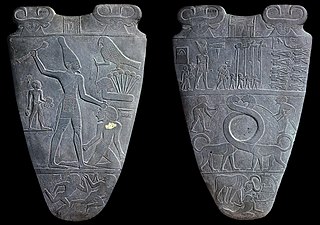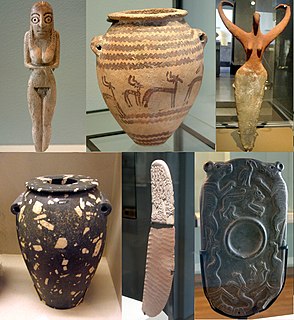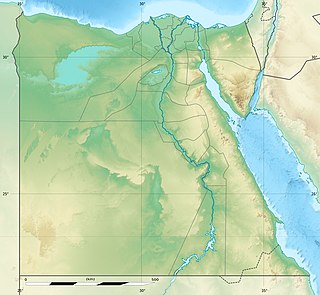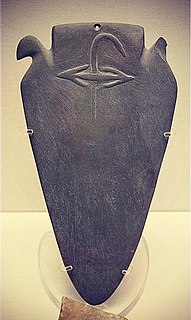
The zoomorphic palette is a type of cosmetic palette made during the predynastic period of Egypt. The palettes are found at burial sites, for example Abydos in the second half of the 4th millennium BC.

The zoomorphic palette is a type of cosmetic palette made during the predynastic period of Egypt. The palettes are found at burial sites, for example Abydos in the second half of the 4th millennium BC.

The term zoomorphic, or animal style, refers to the palette being made in the shape of the animal portrayed. Some examples of similar shaped pieces are made in pottery, specifically drilled stone bowls in a zoomorphic shape. Animal shapes were common in the prehistory of the Iranian regions.
Examples of the animal types represented are turtles, fish, hippopotami, crocodiles, ducks, and elephants. [1] [2] [3]
Many examples feature shell-inlays representing the eyes of the animal. Other details of an animal, such as the fins on a fish, were also commonly depicted with incisions. [3] Some palettes contain suspension holes. [4] In the Naqada II period the centre of these zoomorphic palettes is always left free of decoration to facilitate the functional use of the object. Certain examples feature worn down and damaged centres, as well as staining from the pigment, due to their long history of use, possibly over several generations. It appears that the zoomorphic palette type followed the creation of the Rhomboidal cosmetic palette type. [5]
| Wikimedia Commons has media related to Ancient Egyptian palettes . |

The Narmer Palette, also known as the Great Hierakonpolis Palette or the Palette of Narmer, is a significant Egyptian archeological find, dating from about the 31st century BC, belonging, at least nominally, to the category of cosmetic palettes. It contains some of the earliest hieroglyphic inscriptions ever found. The tablet is thought by some to depict the unification of Upper and Lower Egypt under the king Narmer. On one side, the king is depicted with the bulbed White Crown of Upper (southern) Egypt, and the other side depicts the king wearing the level Red Crown of Lower (northern) Egypt. Along with the Scorpion Macehead and the Narmer Maceheads, also found together in the Main Deposit at Nekhen, the Narmer Palette provides one of the earliest known depictions of an Egyptian king. The Palette shows many of the classic conventions of Ancient Egyptian art, which must already have been formalized by the time of the Palette's creation. The Egyptologist Bob Brier has referred to the Narmer Palette as "the first historical document in the world".

The prehistory of Egypt spans the period from the earliest human settlement to the beginning of the Early Dynastic Period around 3100 BC, starting with the first Pharaoh, Narmer for some Egyptologists, Hor-Aha for others, with the name Menes also possibly used for one of these kings. This Predynastic era is traditionally equivalent to the final part of the Neolithic period beginning c. 6000 BC and ending in the Naqada III period c. 3000 BC.

Scorpion II, also known as King Scorpion, was a ruler during the Protodynastic Period of Upper Egypt.

The serpopard is a mythical animal known from Ancient Egyptian and Mesopotamian art. The word "serpopard" is a modern coinage. It is a portmanteau of "serpent" and "leopard", derived from the interpretation that the creature represents an animal with the body of a leopard and the long neck and head of a serpent. However, they have also been interpreted as "serpent-necked lions". There is no known name for the creature in any ancient texts.

Naqada III is the last phase of the Naqada culture of ancient Egyptian prehistory, dating from approximately 3200 to 3000 BC. It is the period during which the process of state formation, which began in Naqada II, became highly visible, with named kings heading powerful polities. Naqada III is often referred to as Dynasty 0 or the Protodynastic Period to reflect the presence of kings at the head of influential states, although, in fact, the kings involved would not have been a part of a dynasty. In this period, those kings' names were inscribed in the form of serekhs on a variety of surfaces including pottery and tombs.

Cosmetic palettes are archaeological artifacts, originally used in predynastic Egypt to grind and apply ingredients for facial or body cosmetics. The decorative palettes of the late 4th millennium BCE appear to have lost this function and became commemorative, ornamental, and possibly ceremonial. They were made almost exclusively out of siltstone with a few exceptions. The siltstone originated from quarries in the Wadi Hammamat.

The Amratian culture, also called Naqada I, was a culture of prehistoric Upper Egypt. It lasted approximately from 4000 to 3500 BC.

Turtles are frequently depicted in popular culture as easygoing, patient, and wise creatures. Due to their long lifespan, slow movement, sturdiness, and wrinkled appearance, they are an emblem of longevity and stability in many cultures around the world. Turtles are regularly incorporated into human culture, with painters, photographers, poets, songwriters, and sculptors using them as subjects. They have an important role in mythologies around the world, and are often implicated in creation myths regarding the origin of the Earth. Sea turtles are a charismatic megafauna and are used as symbols of the marine environment and environmentalism.

The Gebel el-Arak Knife is an ivory and flint knife dating from the Naqada II d period of Egyptian prehistory, starting circa 3450 BC, showing Mesopotamian influence. The knife was purchased in 1914 in Cairo by Georges Aaron Bénédite for the Louvre, where it is now on display in the Sully wing, room 20. At the time of its purchase, the knife handle was alleged by the seller to have been found at the site of Gebel el-Arak, but it is today believed to come from Abydos.
The ancient Egyptian Game piece (hieroglyph), also a Token, or the general term for any gaming-gambling piece, Draughtsman is an ancient hieroglyph. Gaming pieces were certainly required in predynastic times, as the cultural creation of games and entertainment has a long history in most cultures. An ivory-piece lion is known from the Old Kingdom of Ancient Egypt; the set contains three lions, and three dog tokens of ivory.
The Throw stick hieroglyph of ancient Egypt is an old hieroglyph that dates from the Predynastic Period; it is from the assemblage of hieroglyphs used on the ornamental, or ceremonial cosmetic palettes. It is used on the palettes both as a throwing-stick weapon in the animal hunt being portrayed-(the Hunters Palette), as well as on certain palettes, as a determinative referring to a "foreigner", or "foreign territory".

The Min Palette, or El Amrah Palette is an ancient Egyptian cosmetic palette from El Amrah, found in Naqada, tomb B62. It is held in the British Museum, no. 35501.

The Hunters Palette or Lion Hunt Palette is a circa 3100 BCE cosmetic palette from the Naqada III period of late prehistoric Egypt. The palette is broken: part is held by the British Museum and part is in the collection of the Louvre.

The Bull Palette is the fragment of an Ancient Egyptian greywacke palette, carved in low relief and used, at least in principle, as a cosmetic palette for the grinding of cosmetics. It is dated to Naqada III, the final two centuries of the fourth millennium BC, immediately preceding the Early Dynastic Period). It is in the collection of the Louvre, inventory no. E11255.
The Manshiyat Ezzat Palette is an ornately adorned schist cosmetic palette from predynastic Egypt found at a cemetery in the eastern Delta town of Manshiyat Ezzat, Dakahlia Governorate. The gravesite is from Pharaoh Den's reign, 1st Dynasty. The palette is of low to moderate bas relief.

The fish palettes of predynastic Egypt are one of the common types of cosmetic palettes, or more specifically zoomorphic palettes, which are shaped in the form of the animal portrayed. The fish palettes are mostly ovoid in shape.

The Ancient Egyptian Townsite-city-region (hieroglyph) is Gardiner sign listed no. O49 for the intersection of a town's streets. In some Egyptian hieroglyphs books it is called a City Plan.
Sebilian is a pre-historic archaeological culture in Egypt spanning the period c.13,000-10,000 B.C.

The ancient Egyptians regarded beauty as a sign of holiness. Everything they used had a spiritual aspect to it, including cosmetics. Both men and women wore makeup. Traders traded makeup often, especially in the upper classes. In tombs, cosmetic palettes were found buried in gold with the deceased as grave goods, which further emphasized the idea that cosmetics were not only used for aesthetic purposes but rather magical and religious purposes.
Palette corpus: